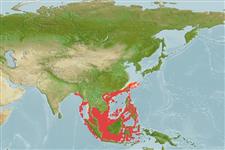Cephalopoda |
Sepiida |
Sepiidae
Environment: milieu / climate zone / Mức độ sâu / distribution range
Sinh thái học
gần đáy; Mức độ sâu 10 - 140 m (Tài liệu tham khảo 1695). Tropical; 28°N - 8°S, 89°E - 128°E (Tài liệu tham khảo 1695)
Indo-West Pacific: from China to the Philippines, Indonesia and Pakistan.
Length at first maturity / Bộ gần gũi / Weight / Age
Chín muồi sinh dục: Lm ? range ? - ? cm Max length : 17.0 cm ML con đực/không giới tính; (Tài liệu tham khảo 275); Khối lượng cực đại được công bố: 0.40 g (Tài liệu tham khảo 275)
It is a demersal species found in inshore soft bottoms (Ref. 128042).
Life cycle and mating behavior
Chín muồi sinh dục | Sự tái sinh sản | Đẻ trứng | Eggs | Sự sinh sản | Larvae
Members of the class Cephalopoda are gonochoric. Male and female adults usually die shortly after spawning and brooding, respectively. Mating behavior: Males perform various displays to attract potential females for copulation. During copulation, male grasp the female and inserts the hectocotylus into the female's mantle cavity where fertilization usually occurs. Life cycle: Embryos hatch into planktonic stage and live for some time before they grow larger and take up a benthic existence as adults.
Roper, C.F.E., M.J. Sweeney and C.E. Nauen 1984 FAO Species Catalogue. Vol. 3. Cephalopods of the world. An annotated and illustrated catalogue of species of interest to fisheries. FAO Fish. Synop. 125(3):277p. Rome: FAO. (Tài liệu tham khảo 275)
IUCN Red List Status
(Tài liệu tham khảo 130435: Version 2025-1)
CITES status (Tài liệu tham khảo 108899)
Not Evaluated
CMS (Tài liệu tham khảo 116361)
Not Evaluated
Threat to humans
Human uses
Các nghề cá: Tính thương mại
| FishSource |
Các công cụ
Thêm thông tin
Sinh thái dinh dưỡngFood items (preys)
Thành phần thức ăn
Thành phần thức ăn
Các động vật ăn mồi
Population dynamicsSự sinh trưởngMax. ages / sizesLength-weight rel.Length-length rel.Length-frequenciesMass conversionSự phong phú Life cycleSự tái sinh sảnChín muồi sinh dụcSự sinh sảnĐẻ trứngEggsEgg developmentLarvae PhysiologyThành phần ô-xy
Human RelatedStamps, coins, misc.
Các nguồn internet
Estimates based on models
Preferred temperature
(Ref.
115969): 23.5 - 28.6, mean 27.8 (based on 560 cells).
Fishing Vulnerability
Low vulnerability (10 of 100).
